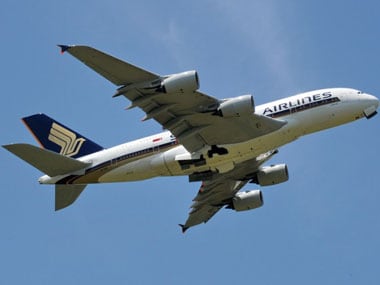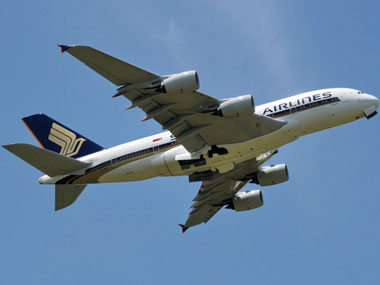For close to five years now, Singapore Airlines has been fighting a losing battle to maintain its position as a premium carrier of choice. From their hubs at Dubai and Doha, middle-eastern carriers Emirates and Qatar Airways have been eating Singapore’s lunch– growing larger, forging new tie-ups and investing billions of dollars in planes, airport-lounges and networks.
Nearer home, the low cost carriers and Asian rivals like Malaysian and Garuda Indonesia are grabbing chunks of traffic.
The joint venture with the Tatas is the latest in a series of steps being taken by CEO Goh Cho Phoong to arrest the slide.
[caption id=“attachment_1122105” align=“alignleft” width=“380”]
 AFP[/caption]
AFP[/caption]
Late last year, Goh outlined a portfolio strategy that would allow the SIA group to compete in multiple market segments. Tiger Airways, a joint venture (with Tony Ryan of Ryanair and IndiGo partners) and Scoot will cover the low cost segments, while SilkAir and Singapore Airlines focus on premium passengers. In the “catch-all’’ strategy- Tiger is the short-haul LCC, Scoot is the long-haul LCC, SilkAir is the regional full-service arm, while SQ remains the long-haul, premium carrier.
Though launched with fanfare, the LCCs are still work in progress. Over the years, Singapore Airlines has heavily focussed on North American passenger and global cargo traffic, which have remained weak. The only way out of the rut was to have partnerships in growing markets like India and China. Bilateral agreements limit operations in both these countries. For instance, Singapore Airlines (with SilkAir) has 107 flights a week to India. In comparison, Emirates already operates 185 and the much smaller Sharjah-based LCC Air Arabia has 111 flights a week.
Impact Shorts
More ShortsIndia calling
For Singapore Airlines’ lead investor Temasek, the airline JV is just the beginning. There are dozens of areas for synergy between the two partners. Aircraft sourcing, maintenance, ground services, fuel, cargo and catering are the obvious ones. The SIA group has very strong, profitable subsidiaries that have been in each of these activities for decades. Many of them already have JVs in India. The airline JV is certain to be followed up by announcements for new partnerships in these related areas.
Going by current Indian rules, the new airline will have to operate for five years as a domestic carrier, before it is allowed to start flying overseas. This would mean Tata Airlines, as the new carrier may well be called- in deference to JRD’s name for the airline he started in 1932, will feed domestic traffic into Singapore Airlines. It could, of course, jump the queue by buying an existing airline that has the rights.
Goh, seems to have been preparing ground for new partnerships by ordering a massive number of planes in the last one year. By international standards, Singapore Airlines is a mid-sized airline with a 101 planes in its fleet. But a look at the number of aircraft on order, reveals its ambitious plans. A year ago, it announced a $7.5 billion order for 20 Airbus A350-900s and 5 A380 superjumbos. This was followed by a $7 billion order this May, for 30 more A350-900s and 30 yet-to-launched Boeing 787-10X Dreamliners. Singapore Airlines now has firm orders for 70 A350-900s that cover its needs well into the next decade.
Speaking to analysts Goh had said, “The aircraft orders are among the biggest in Singapore Airlines’ history, helping to ensure that we retain our industry leading position. They demonstrate our commitment to the Singapore hub and our confidence in the future for premium full-service travel.”
The planes are obviously an attempt to match the extensive European and North American networks of Middle Eastern carriers by flying to secondary European cities currently not served by SIA but by Emirates, Qatar Airways and Etihad Airways. Such cities include St. Petersburg, Dublin, Madrid, Lisbon, Geneva, Warsaw, Prague, Vienna, Dusseldorf, Venice, Hamburg in Europe; Seattle, Dallas, Toronto and Washington DC.
The other attempt is to upgrade its offering. From this month, Singapore Airlines will start rolling out its new, upgraded First and Business class cabins. The airline is spending $150 m on the upgrade, to stay abreast of rivals. As far as Goh’s plans for Singapore Airlines go, Delhi is one important step in a long journey.
Cuckoo Paul is Associate editor at Forbes India. She spends most of her time looking for interesting business stories. She is biased towards tales of dirty, old-style, brick-and-mortar companies in the oil & gas, power and heavy engineering business. Apart from refining margins, her other obsession is with things airborne. She learnt flying on a Piper Super Cub and follows commercial and general aviation keenly. She is also on the board of Childfund India, an NGO that supports about 70,000 children in the country.
)